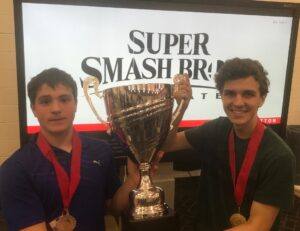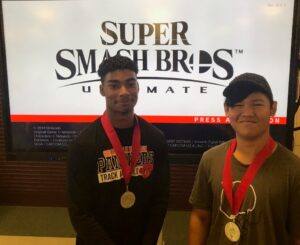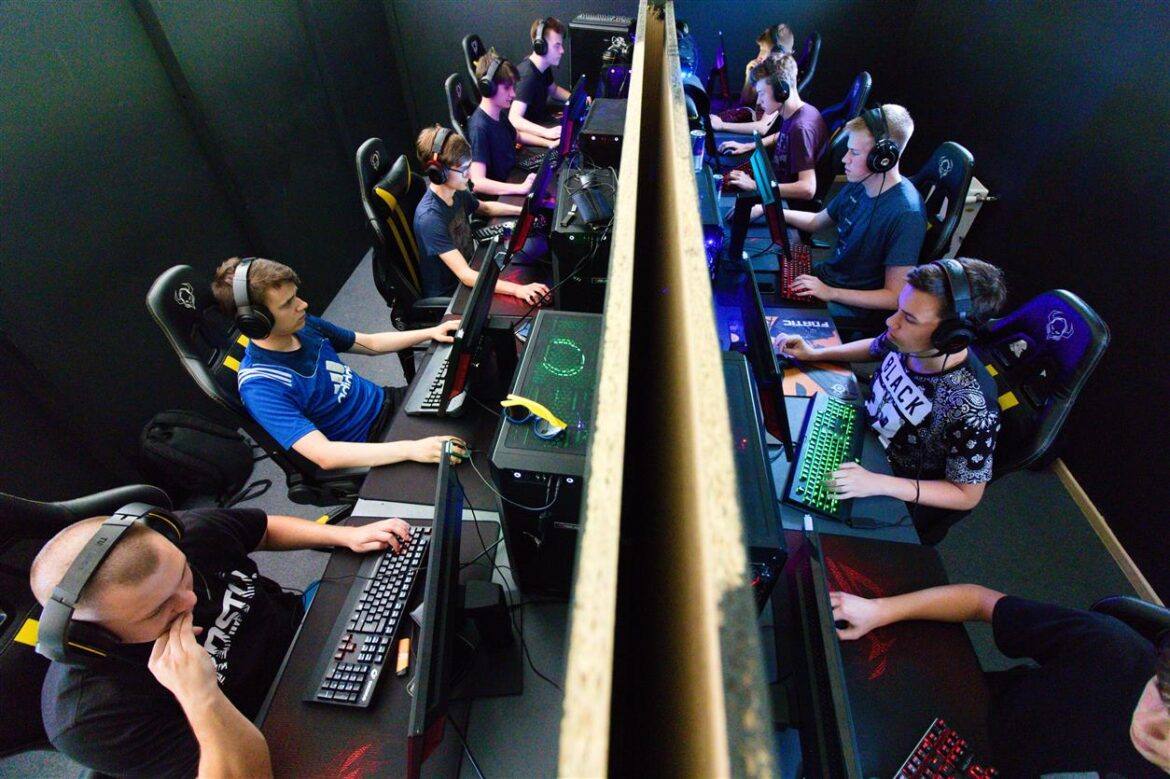Kyle Berger, chief technology officer at Grapevine-Colleyville ISD, began an esports program at the district during the 2018-19 school year. I met Kyle while attending an Esports Summit in Arlington last month. After hearing a little bit about the esports program he started, I wanted to learn more. I had the opportunity to interview Kyle a few weeks ago and ask him a few questions about his experiences, successes, and future plans for the Grapevine-Colleyville’s esports program. According to Kyle, “This has been the biggest thing I’ve underestimated in my career.”
How did your journey with esports start?
Our real journey started probably about two years ago and it came about because I was noticing the rise of esports on the collegiate side. I was visiting with a couple of local colleges in the Dallas-Fort Worth area, and they began mentioning scholarship opportunities for students. At Grapevine-Colleyville, we are always trying to find ways to connect our students with colleges. In addition, we have a large partnership with Dell. I reached out to Dell about what they were seeing with esports. In addition, you don’t have to be gamer to get this started. If you asked me a month ago, what League of Legends was, I wouldn’t have had any idea.
How did you launch the esports program at Grapevine-Colleyville?
Last year, we formally launched our esports program. I’ve been a CTO for 20 years and this is the biggest thing I’ve underestimated in my career just due to the overwhelming response to student interest.
We started with 75 official esport athletes between our two high schools. By official, I mean these students were on competition teams and would practice after school. This is different from having a gaming club where students get together in the library to play games. Our program has a lot of structure around it.
As we began looking at our data this summer, some interesting facts included:
- 70% of our esport students were not involved in any other school activity. Anytime you can get a student involved in some sort of other activity on campus, the other benefits that come with that are just tremendous.
- 10% of our esports students are autistic. We were gathering kids of this nature that don’t have other areas to get involved.
- We have a few girls in the program, which is very exciting.
- Four different college recruiters have already started calling to ask about our students.
All of these facts are something that we did not anticipate just starting out.
What do districts need to consider before starting their esports program?
Different districts approach esports differently. Some questions to think about include:
- What is your district’s intent with the esports program? It is important to determine if your program is going to be a gaming club or if it is going to be actual structured play. For us, we talked with our students and sent surveys out to find out where their interest was. We decided structured play would work best for us. Our structure consists of before-school practice and after-school play.
- What games are you going to play?
The games that students are always going to want to play are Fortnight or some of the more violent games. Some districts allow this; however, our stance at Grapevine-Colleyville ISD is that we don’t allow any violent or first-person shooter (known as FPS in the gaming industry). We focus on games that have some type of team structure; we don’t want solo-player games. When there are multiple players on a team, we can build collaborative skills. Traditional athletics follows the same model. The primary games you will see in esports programs are:
- League of Legends
- Rocket League
- Overwatch
- Smash Brothers Ultimate
- What league are you going to play with?
This is one of the scariest sides for me in esports right now. They call it the wild west of esports leagues because there’s all sorts of companies popping up online that are high school esports leagues. Therefore, you have to determine what league am I going to join for my students to play in. There are several options out there. This is a big decision that the district has to make.
How do you find a league to join?
To find a league to join, a general Google search will get you many options. When it comes to finding a league, a thing to be cautious of is that there are leagues all across the country. For us, we went with Play VS or some people call it play verse. One of the reasons we went with them is because they have a partnership with the National Federation of High School Associations which is also connected back to UIL. They also restrict the games that are played. This is similar to what we are doing with our esports programs. The games focus on education and are not violent.
Structure
Be aware that some leagues might not necessarily have structure built into their program. For example, Play VS has a structure in place in which all students must be on campus in order to play in the competition. Some leagues don’t care and allow students to play from home. Play VS promotes team play, and there is actual coaching involved. This is what takes it to another level for me because all the students are together and involved.
Scheduling
In addition, when considering a league to join, be aware of potential scheduling issues. We were playing teams across the country and time zone differences made it more difficult to schedule times to play. The time of year, such as spring break, made it difficult to manage as well. Due to demand, Play VS now has a Texas-specific league, so we can connect and play other Texas schools.
Schools
Furthermore, there are leagues that have a mixture of private schools, charter schools, or public schools. Your district must decide if there is a preference of what type of schools they want to play.
Vetting Leagues
It’s critical that you vet the league to make sure that it is schools and students that you are playing. You always want to make sure you know who is on the other side playing with your students. You want to avoid online dangers and do your due diligence to ensure that the league you are associating with is credible.
Make sure the playing field is equal
Sometimes, pop-ups come with games that allow you to pay money for extra features. Some esports leagues have partnerships with the video game manufactures to unlock the games completely for the end user so that there is an equal playing field. It would be a disadvantage for some schools to purchase additional features if your school doesn’t have the money to do so. Some leagues do allow this. Play VS, for example, has a partnership with League of Legends that unlocks the game for all the students so that all of them have e access to the same features. This is something I feel very passionate about: everyone is playing on an equal playing field and it breaks down the barriers.
When do students practice and play?
We have one night a week of structured competition play. For example, every Tuesday night. We usually start at 4:30 pm and end about 6:30 pm.
Our overall structure consists of:
- Monday – The team will practice and review game film. They scout the opponents they will play and watch game film of their opponent. This is much like scouting in football.
- Tuesday – The competition match is held.
- Wednesday – The team will review the game of the night before.
- Thursday – Traditional practice is held.
Our broadcasters might attend practices to practice their commentary skills as well.
Do you have an esports curriculum?
We have developed a curriculum to work with our esports teams and have written a half-semester course that covers all aspects of fitness, nutrition, communication, collaboration, and the different components surrounding esports.
Esports is more than just the players. We have students that are streaming the matches live. We have students in charge of marketing and Twitter feeds. We have students in charge of game film. We have analysts. It’s just not students playing video games. There are so many jobs available that support esports.
Pro esports athletes are making millions of dollars. It’s the same concepts of those students trying to make the NFL. Only a small percentage will make it, but there are many jobs available around it, such as coaching, media, legal, business, etc. That is what our esports program is preparing our students for as well. There is a wealth of opportunities for students to get involved with and not just as the player.
We also reached out to our partner, Dell to help us find esports curriculum. Dell’s computer hardware subsidiary is called Alienware. Their products are designed for gaming and can be identified by their alien-themed designs. Through Dell, we were able to connect with esport industry professionals and curriculum writers. We also involve our students in order to get student voice when it comes to curriculum. Together with esport industry professionals, curriculum writers, our esports coaches, and our students, we mapped out what that course would look like. We really stress “beyond the game” in our lessons.
We have submitted to TEA to get an official course number so we can hopefully offer the course next year. Currently, we are testing the curriculum in our after-school practices. Next year, the curriculum will also bleed into our existing traditional broadcasting classes and sports marketing classes. As we build out, we are looking to have esport broadcasting classes and esports marketing classes.
Do your esports coaches need to be certified?
Currently, a certification program for esports coaches/teachers doesn’t exist. This is one of the biggest challenges in esports. For us, finding the right person to lead the program started with someone who can build great relationships with students. Our students are the experts. They know the games. Therefore, we wanted someone who would nurture and work with them to build the program together. Our coaches do have some interest in gaming, but are not hard-core gamers. Ultimately, it came down to the person who could build relationships with our students. Currently, our coaches are classroom teachers, and we do offer a coaching stipend to them. We provide a stipend because it is like a traditional sport with after-school practices and games. Last year, we had two coaches, one at each campus. This year, we will be expanding that due to growth in the program. Currently, we have two coaches at each campus and one coach at our collegial campus.
How many students are involved in the esports program?
If you grow too big too fast, it can get out of control. The overwhelming response can be detrimental to you. I recommend that you cap your program, and this can be dependent upon the games you select. For example, if you have selected League of Legends as a game choice, you will need five active players and then you’ll want one or two subs. If you have selected Rocket League, you’ll need three active players and a few subs. We ran two League of Legends teams at each high school, so that was about 12-14 students. We also ran three Rocket League teams at about 15-16 students. These are just the players. Keep in mind that we also have our broadcasters, media specialists, etc.
We are looking to peak at 250 students this year. We will run a varsity structure. We will have a JV and Varsity team and we will run four teams for each game.
What do tryouts for the esports program look like?
We started with informational meetings. With our parent information meetings, we wanted to make sure parents understood what esports is and that we aren’t just playing video games. There is a lot of structure to the program that parents needed to be made aware of. Even though it is not UIL sanctioned yet, we still follow those same rules like the no pass, no play rule. We also wanted to reassure the parents that we would not be playing violent games.
For our initial student interest meeting, we had about 150 students show up. So, we had to figure out how we were going to manage this. Do not underestimate the amount of interest you will generate. Initially, we had a registration process, which consisted of teacher reference letters and grade checks. Some students realized they didn’t want to be involved when they discovered that Fortnight wasn’t a game being played.
This year, our students who helped build the program are helping with the tryout structure. Things that may be considered could be their existing ranking if they are already playing at home. The students will also have matches and play games with each other to see how well they play together. How well they play together strategically is very important. There are specific positions that students play in the game as well. Therefore, this is something else you need to look at.
Some districts hold tournaments. Those students who advance to certain rounds of the tournament are the ones selected to be on the competition teams. We use the month of September to have our informational meetings, registration, and tryouts, and practices. In October, we start our official matches.
What equipment do schools need? What about funding?
Some games can be played on traditional computers, but we have higher-end video game machines. Our game lab consists of 12 competition gaming units along with traditional computers. Both the League of Legends and Rocket League don’t require that you have a fancy machine to play. This is the benefit of both of those games.
Something to think about is that sometimes our CTE courses require higher-end computers. See if there is a way you can utilize those machines after school to support your esports program, then you can build from there. For funding, we look to CTE because we can also use those machines for courses, such as AutoCAD or video game design. Also, in our traditional replacement cycle, we may upgrade a few machines a little more for our esports program.
And finally, many thanks to Kyle!
A big thank you to Kyle for allowing me to interview him and for sharing his knowledge about esports. Find out more about Grapevine-Colleyville’s esport’s program here. In addition, you can find Kyle on Twitter at @edtechcto. And check out his interview on the TCEA podcast Ed Tech Club.


